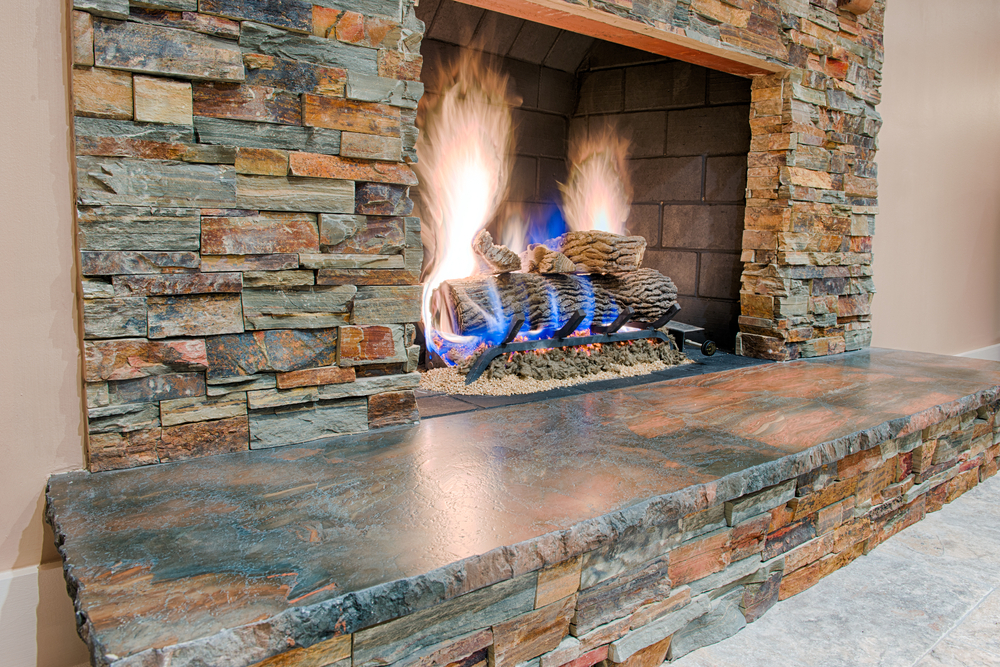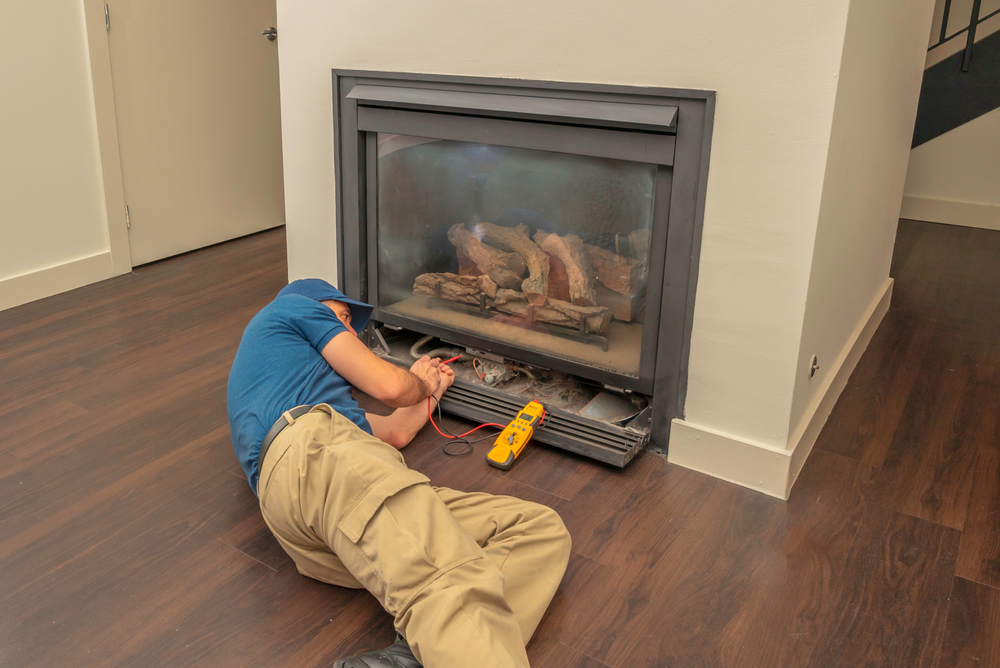Gas Fireplace Cleaning Atlanta
Did you know that your gas fireplace needs to be serviced every year to ensure safe operation?
If you are like most people you were unaware of this necessity.
It is recommended that a licensed gas service technician inspects your gas fireplace annually to ensure the safe, efficient, and reliable operation of your gas unit.
For the safety of your home, it is recommended that both gas fireplaces and wood-burning fireplaces including stove inserts and pellet stoves be serviced once a year. Any time you have a live-fire burning in your home you want to make sure everything is performing at optimal efficiency for safety and reliability.
There are a lot of moving parts in gas fireplaces. Servicing those parts to make sure they have been adjusted appropriately and identifying when they need to be replaced will give you peace of mind when using your appliance. Those parts will also last longer when they are serviced on an annual basis saving you money in the long run.
Another thing to consider is that there is a higher risk of having a carbon monoxide issue due to parts wearing out if you do not get your gas fireplace inspected by a professional every year.
If you don’t use your gas unit often there is a possibility of bugs and spiders in the venting living and spinning webs. This can cause issues with proper venting and can also be a factor in causing a carbon monoxide issue.
So even though gas fireplaces don’t cause creosote build up like in a wood-burning fireplace there can still be issues with parts needing to be replaced or adjusted. A yearly inspection is the solution to keeping your family safe from carbon monoxide leaks due to unexpected failure of worn-out parts.
We offer gas fireplace repair and cleaning here in Atlanta, Georgia. Chimcare started years ago as a family-based business. Since then we have grown from one chimney sweep to a crew of licensed gas fireplace technicians offering you home solutions from fireplace inspection, cleaning, installation, and other related services.
Simply call to schedule an inspection and gas fireplace cleaning which includes the safety inspection. This service will give you peace of mind, save you money, and could save your life.
Facts About Atlanta
Climate
| Jan | Feb | Mar | Apr | May | Jun | |
|---|---|---|---|---|---|---|
| Average high in ºF | 61 | 52 | 72 | 82 | 86 | 87 |
| Average low in ºF | 43 | 37 | 54 | 64 | 69 | 70 |
| Days with precipitation | 8 | 11 | 7 | 7 | 10 | 12 |
| Hours of sunshine | 188 | 160 | 241 | 247 | 285 | 284 |
| Av. precipitation in inch | 2.95 | 4.37 | 2.44 | 3.27 | 3.58 | 4.72 |
| Jul | Aug | Sep | Oct | Nov | Dec | |
|---|---|---|---|---|---|---|
| Average high in ºF | 86 | 79 | 71 | 54 | 62 | 51 |
| Average low in ºF | 67 | 60 | 51 | 37 | 43 | 35 |
| Days with precipitation | 10 | 9 | 10 | 10 | 12 | 11 |
| Hours of sunshine | 304 | 309 | 266 | 165 | 218 | 154 |
| Av. precipitation in inch | 3.82 | 3.15 | 4.49 | 4.53 | 5.35 | 4.45 |
Source: https://www.usclimatedata.com/climate/atlanta/georgia/united-states/usga0028
The 2010 United States Census reported that Atlanta had a population of 420,003. The population density was 3,154 per square mile (1232/km2). The racial makeup and population of Atlanta was 54.0% Black or African American, 38.4% White, 3.1% Asian and 0.2% Native American. Those from some other race made up 2.2% of the city’s population, while those from two or more races made up 2.0%. Hispanics of any race made up 5.2% of the city’s population.[114] The median income for a household in the city was $45,171. The per capita income for the city was $35,453. 22.6% percent of the population was living below the poverty line.
In the 1920s, the black population began to grow in Southern cities like Atlanta, Birmingham, Houston, and Memphis.[115] In the 2010 Census, Atlanta was recorded as the nation’s fourth-largest majority-black city. The New Great Migration brought an insurgence of African Americans from California[116] and the North to the Atlanta area.[117][118] It has long been known as a center of African-American political power, education, economic prosperity, and culture, often called a black mecca.[119][120][121] Some middle and upper class African-American residents of Atlanta followed an influx of whites to newer housing and public schools in the suburbs in the early 21st century. From 2000 to 2010, the city’s black population decreased by 31,678 people, shrinking from 61.4% of the city’s population in 2000 to 54.0% in 2010, as the overall population expanded and migrants increased from other areas.[69]
At the same time, the white population of Atlanta has increased. Between 2000 and 2010, the proportion of whites in the city had notable growth. In that decade, Atlanta’s white population grew from 31% to 38% of the city’s population, an absolute increase of 22,753 people, more than triple the increase that occurred between 1990 and 2000.[122]
Early immigrants in the Atlanta area were mostly Jews and Greeks. Since 1970, the Hispanic immigrant population, especially Mexicans, has experienced the most rapid growth, particularly in Gwinnett, Cobb, and DeKalb counties.[123] Since 2010, the Atlanta area has seen very notable growth with immigrants from India, China, South Korea, and Jamaica.[124][125] Other notable countries immigrants come from are Vietnam, Eritrea, Nigeria, the Arabian gulf, Ukraine and Poland.[126] Within a few decades, and in keeping with national trends, immigrants from England, Ireland, and German-speaking central Europe were no longer the majority of Atlanta’s foreign-born population. The city’s Italians included immigrants from northern Italy, many of whom had been in Atlanta since the 1890s; more recent arrivals from southern Italy; and Sephardic Jews from the Isle of Rhodes, which Italy had seized from Turkey in 1912.[127]
Of the total population five years and older, 83.3% spoke only English at home, while 8.8% spoke Spanish, 3.9% another Indo-European language, and 2.8% an Asian language.[128] 7.3% of Atlantans were born abroad (86th in the US).[114][129] Atlanta’s dialect has traditionally been a variation of Southern American English. The Chattahoochee River long formed a border between the Coastal Southern and Southern Appalachian dialects.[130] Because of the development of corporate headquarters in the region, attracting migrants from other areas of the country, by 2003, Atlanta magazine concluded that Atlanta had become significantly “de-Southernized”. A Southern accent was considered a handicap in some circumstances.[131] In general, Southern accents are less prevalent among residents of the city and inner suburbs and among younger people; they are more common in the outer suburbs and among older people.[130] At the same time, some residents of the city speak in Southern variations of African-American English.[132]
Source:https://en.wikipedia.org/wiki/Atlanta#Demographics




 >
>
Leave a Reply